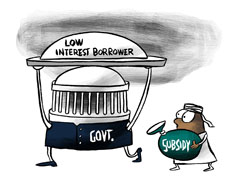Forced into HDFC Life Sampoorn Nivesh Plan for Locker: What Should I Do?
Ramalingam Kalirajan |9620 Answers |Ask -Follow
Mutual Funds, Financial Planning Expert - Answered on Aug 16, 2024
He has an MBA in finance from the University of Madras and is a certified financial planner.
He is the director and chief financial planner at Holistic Investment, a Chennai-based firm that offers financial planning and wealth management advice.... more

Hi Ramalingam Sir, I was forced by HDFC bank person to open HDFC life sampoorn nivesh plan for locker facility in may 2024. I am realising i made a bis mistake now. Could you please advise me whst to now?
Evaluating the HDFC Life Sampoorn Nivesh Plan
The first step is to understand what you’ve signed up for:
Nature of the Plan: This plan is a combination of insurance and investment. While it offers life cover, the investment returns are usually lower compared to other pure investment options.
Charges and Fees: Insurance-cum-investment plans often have higher charges. These include premium allocation charges, policy administration charges, and fund management charges. These charges can eat into your returns, reducing the overall growth of your investment.
Lock-in Period: Most such plans have a lock-in period, usually five years. During this time, surrendering the policy can result in significant losses, as surrender charges are high, and the amount you receive may be less than what you’ve paid.
Investment Returns: The returns on such plans are generally modest. The money invested in the fund options provided may not grow as much as other investment avenues like mutual funds or direct equity.
Assessing Your Financial Goals
Now that you understand the plan, align it with your financial goals:
Insurance Needs: Do you need life insurance? If yes, a term insurance plan would provide better coverage at a lower cost. Evaluate if the life cover provided by this plan is sufficient for your needs.
Investment Goals: If your primary goal is investment, then consider other options. Mutual funds, especially actively managed ones, can offer better returns over time. They also provide the flexibility to invest according to your risk profile.
Lock-in Concerns: The lock-in period restricts your ability to access your money. Consider if you can afford to keep this investment locked in or if you need liquidity.
Surrendering the Policy
If you decide that this plan doesn’t suit your needs, here’s what you can do:
Surrender Charges: Be aware of the surrender charges. If you surrender within the first few years, these charges can be significant. The surrender value might be less than the premiums paid.
Free-Look Period: If you’re still within the free-look period (usually 15-30 days from receiving the policy document), you can cancel the policy without penalties. You’ll receive a refund of the premium after deducting administrative charges.
Paid-Up Option: If you’re past the free-look period but still want to exit, you can consider making the policy paid-up. This means you stop paying further premiums, and the policy continues with reduced benefits until maturity.
Complete Surrender: If you choose to surrender, you’ll receive the surrender value after deducting charges. Evaluate this against your financial needs and alternative investment options.
Reinvesting the Proceeds
If you choose to surrender or make the policy paid-up, think about how to reinvest the money:
Mutual Funds: Actively managed mutual funds offer potentially higher returns and flexibility. They are also more transparent, with lower charges compared to insurance-cum-investment plans. A Certified Financial Planner can guide you in selecting funds that match your risk tolerance and goals.
Public Provident Fund (PPF): If you’re looking for a safe, long-term investment with tax benefits, PPF is a good option. It offers guaranteed returns and is backed by the government.
Systematic Investment Plans (SIPs): Investing in SIPs ensures disciplined savings. It also helps you take advantage of market fluctuations by averaging the purchase cost over time.
Emergency Fund: Consider setting aside some of the proceeds in an emergency fund. This will ensure you have liquidity in case of unexpected expenses.
Taking Action Against Mis-selling
If you were coerced into buying this policy, you can take steps to address the issue:
Contact the Bank: First, approach HDFC Bank and explain your situation. They may offer a solution, especially if you were misled during the sale.
Complaint to the Insurer: If the bank doesn’t resolve your issue, file a complaint directly with HDFC Life. They have a grievance redressal mechanism in place.
Approach IRDAI: If you’re not satisfied with the response from the insurer, you can escalate the matter to the Insurance Regulatory and Development Authority of India (IRDAI). They can investigate and take action if there was any malpractice involved.
Consumer Forum: As a last resort, you can approach the consumer forum. This may take time, but it’s an option if all other avenues fail.
Protecting Yourself in the Future
To avoid similar situations in the future, consider the following:
Do Your Research: Before buying any financial product, take time to research. Understand the product, its benefits, and its drawbacks. Don’t rush into decisions based on sales pressure.
Seek Professional Advice: Consult a Certified Financial Planner before making any significant financial decisions. They can provide unbiased advice tailored to your needs.
Understand Your Rights: Know your rights as a consumer. You have the right to information, the right to choose, and the right to redressal if you’re sold a product under false pretenses.
Be Wary of Cross-Selling: Banks often cross-sell insurance and investment products. Be cautious when a bank tries to push a product that you didn’t ask for. Remember, you’re not obligated to buy any financial product to avail of a service like a locker facility.
Finally
You’ve taken the first step by recognising that the HDFC Life Sampoorn Nivesh plan may not be the right fit for you. Now, it’s about taking informed actions. Whether you choose to surrender the policy, make it paid-up, or keep it active, ensure that the decision aligns with your financial goals. Consider consulting a Certified Financial Planner for personalised advice. Your financial well-being is important, and making the right decisions now will benefit you in the long run.
Best Regards,
K. Ramalingam, MBA, CFP,
Chief Financial Planner,
www.holisticinvestment.in
Best Regards,
K. Ramalingam, MBA, CFP,
Chief Financial Planner,
www.holisticinvestment.in
You may like to see similar questions and answers below
Ramalingam Kalirajan |9620 Answers |Ask -Follow
Mutual Funds, Financial Planning Expert - Answered on May 26, 2024
Ramalingam Kalirajan |9620 Answers |Ask -Follow
Mutual Funds, Financial Planning Expert - Answered on Jun 03, 2024
Milind Vadjikar | Answer |Ask -Follow
Insurance, Stocks, MF, PF Expert - Answered on Apr 22, 2025
Nayagam P P |8437 Answers |Ask -Follow
Career Counsellor - Answered on Jul 10, 2025
Nayagam P P |8437 Answers |Ask -Follow
Career Counsellor - Answered on Jul 10, 2025
Nayagam P P |8437 Answers |Ask -Follow
Career Counsellor - Answered on Jul 10, 2025
Nayagam P P |8437 Answers |Ask -Follow
Career Counsellor - Answered on Jul 10, 2025
Ramalingam Kalirajan |9620 Answers |Ask -Follow
Mutual Funds, Financial Planning Expert - Answered on Jul 10, 2025
Ramalingam Kalirajan |9620 Answers |Ask -Follow
Mutual Funds, Financial Planning Expert - Answered on Jul 10, 2025
Ramalingam Kalirajan |9620 Answers |Ask -Follow
Mutual Funds, Financial Planning Expert - Answered on Jul 10, 2025
Ramalingam Kalirajan |9620 Answers |Ask -Follow
Mutual Funds, Financial Planning Expert - Answered on Jul 10, 2025
Nayagam P P |8437 Answers |Ask -Follow
Career Counsellor - Answered on Jul 10, 2025
Ramalingam Kalirajan |9620 Answers |Ask -Follow
Mutual Funds, Financial Planning Expert - Answered on Jul 10, 2025





















